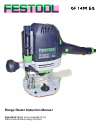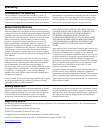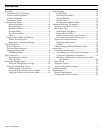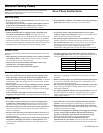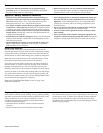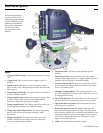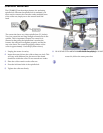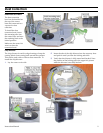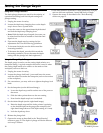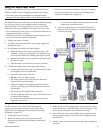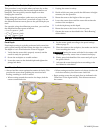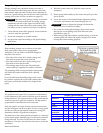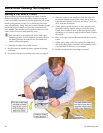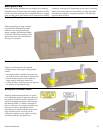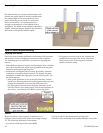
Service
► Tool service must be performed only by qualified repair
personnel. Service or maintenance performed by unqualified
personnel could result in a risk of injury.
► When servicing a tool, use only identical replacement parts.
Use of unauthorized parts or failure to follow maintenance
instructions may create a risk of electric shock or injury.
Specific Safety Rules for Routers
► Hold the tool by the insulated handles when performing an
operation in which the cutter may contact hidden wiring or its
own cord. Contact with a “live” wire will make the exposed
metal parts of the tool “live” and shock the operator.
► Use clamps or another suitable means to support and secure the
workpiece to a stable platform. Holding the workpiece by hand
or against your body is unstable and may lead to loss of control.
► Always make sure the work surface is free from nails and other
foreign objects. Cutting into a nail can cause the bit and the tool
to jump and damage the bit.
► Keep hands away from the cutting area. Keep your second hand
on the auxiliary handle. If both hands are holding the tool, they
cannot be cut by the bit.
► NEVER hold the piece being cut in your hands or across your
leg. It is important to support the work properly to minimize
body exposure or loss of control.
► After changing the bit or making any adjustments, make sure
the collet nut and any other adjustment devices are securely
tightened. A loose adjustment device can unexpectedly shift,
causing loss of control, and loose rotating components can be
violently thrown.
► Never start the tool when the bit is engaged in the workpiece.
The cutting bit may grab and cause loss of control.
► Always feed the router against the rotation of the bit (called
push-cutting).
► Never operate the router with the cutting tool engaged in the
workpiece without locking the plunge lock knob. Unexpected
changes in cutting depth can result in a violent loss of control.
Router Feed Direction
For safety and control, the router should always be fed in the
direction against the rotation of the bit. This is called push-cutting
(among other names). Feeding the router in the same direction as
the bit rotation is called climb-cutting, and is extremely dangerous.
When fed in the push-cut direction, the router bit resists forward
movement and provides greater control to the operator.
If a router is fed in the climb-cut direction, the router bit tends to
self-feed, climb, or walk its way down the edge of the workpiece.
Feeding in this direction can, and will, cause the router to grab
suddenly and jerk down the workpiece, resulting in loss of control.
Special care needs to be taken when making dado cuts and plunge
cuts with a router because one side of the bit is push-cutting, and
the other side is climb-cutting. This can have unpredictable results
as each side of the bit engages the workpiece.
Refer to the "
Feed Direction Rules" section on page 12 for
additional information.
Respiratory Exposure Warning
Various dust created by power sanding, sawing, grinding, drilling
and other construction activities contains chemicals known (to the
State of California) to cause cancer, birth defects or other
reproductive harm. Some examples of these chemicals are:
► lead from lead-based paints,
► crystalline silica from bricks, cement, and other masonry
products,
► arsenic and chromium from chemically-treated lumber.
The risk from these exposures varies, depending on how often you
do this type of work. To reduce your exposure to these chemicals:
work in a well ventilated area, and work with approved safety
equipment, such as dust masks that are specially designed to filter
out microscopic particles.
Instruction Manual 5



